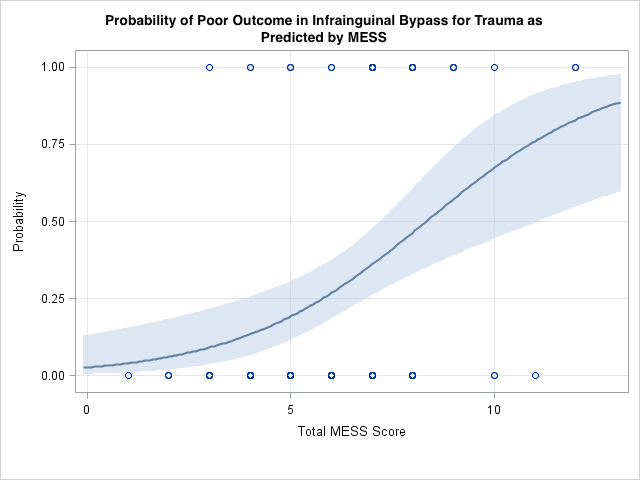Predictors of Outcome in Infrainguinal Bypass for Trauma
Hunter M. Ray, MD, Harleen K. Sandhu, MD, MPH, Charles C. Miller, PhD, Rana Afifi, MD, Edmundo Dipasupil, Ali Azizzadeh, MD, Kristofer Charlton-Ouw, MD.
The University of Texas Medical School at Houston, Houston, TX, USA.
OBJECTIVES:
Vascular injuries are present in 1-2% of trauma cases and can lead to significant morbidity. We determine outcome predictors in infrainguinal bypasses done for trauma.
METHODS:
In patients between 1999-2015, we defined poor outcome as a composite of: thrombosis leading to graft abandonment, reoperation, major amputation, or death. Data were analyzed by stratified Kaplan-Meier and multiple Cox regression.
RESULTS:
Infrainguinal arterial bypasses were done in 108 patients (45 end-to-side and 63 interposition). Mean age was 35±17 years-old; 10/108 (10%) had diabetes mellitus (DM); median Injury Severity Score (ISS) was 12 (IQR 9-18); median glomerular filtration rate (GFR) was 77.5 (IQR 59-92); median Mangled Extremity Severity Score (MESS) was 6 (IQR 5-7); 39/108 (36%) had blunt injury; and 76/108 (70%) had an infrageniculate target for bypass. Univariate risks for poor outcome include age >40 years (48% vs 21%, p<0.01); MESS>7 (51% vs 14%, p<0.01); blunt mechanism (39% vs 15%, p<0.01); diabetes (70% vs 27%, p<0.01); and infrageniculate target (37% vs 16%, p<0.03). MESS>7 was 73% sensitive and 70% specific in predicting poor outcomes.
Probability of poor outcome rose to 95% with MESS ≥12 (Figure 1). Age (OR 1.03/year, p<0.04) and MESS>7 (OR 3.8, p<0.02) were persistently associated with poor outcome in multivariable analysis. In stratified analysis, interposition grafts fared worse only in penetrating injuries with composite poor outcome in 0/13 (0%) in end-to-side vs. 6/26 (23%) in interposition bypass (RR 1.3; 95% CI 1.1-1.6; p<0.03).
CONCLUSIONS:
Poor outcomes in infrainguinal bypass for trauma are associated with age >40 years, MESS>7, blunt mechanism, infrageniculate target as well as history of DM. Interestingly, interposition bypasses had worse outcomes compared to end-to-side bypasses only in penetrating injures.

Back to 2018 ePosters




